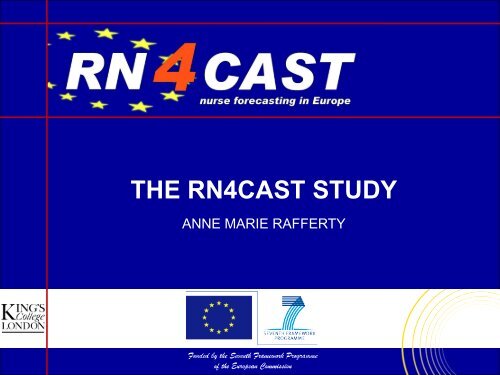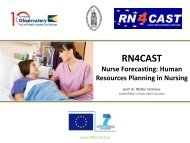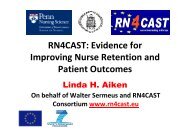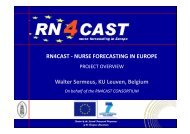Create successful ePaper yourself
Turn your PDF publications into a flip-book with our unique Google optimized e-Paper software.
THE <strong>RN4CAST</strong> STUDY<br />
ANNE MARIE RAFFERTY
CONTENTS<br />
• The <strong>RN4CAST</strong> study<br />
• Funding<br />
• Consortium<br />
• Objective<br />
• Design<br />
• <strong>RN4CAST</strong> results: The relationship between hospital nursing<br />
organization of care and patient satisfaction and nurse<br />
wellbeing.<br />
• Further steps<br />
2
<strong>RN4CAST</strong> RATIONALE<br />
• Worldwide numeric, skill, and geographic imbalances in healthcare<br />
and nursing workforce.<br />
• The workforce crisis is likely to increasingly affect quality and<br />
safety of healthcare and health system performance.<br />
• Strategic investments in healthcare and nursing workforce are<br />
expected to accelerate health gains by enhancing the performance<br />
of health care organizations and health systems.<br />
3
<strong>RN4CAST</strong> RATIONALE<br />
• Nursing workforce planning and forecasting efforts…<br />
• have a poor record of accurately predicting future nursing<br />
workforce needs and of informing policy interventions that<br />
avoid cyclical shortages.<br />
• don’t take into account the dynamics between nurse-to-patient<br />
ratios, skill mix, nurse education level, and nursing work<br />
environment on one hand and nurse wellbeing and patient<br />
outcomes on the other hand.<br />
4
<strong>RN4CAST</strong> RATIONALE<br />
Example of the dynamics between nursing organization of care<br />
and patient outcomes and nurse wellbeing (Aiken et al., 2010)<br />
Nurse staffing levels in Californian hospitals increased<br />
substantially after mandated minimum nurse-to-patient<br />
ratios. When compared to states with higher workloads,<br />
Californian workloads are associated to lower patient<br />
mortality, and lower nurse burnout, job dissatisfaction<br />
and, and better nurse-perceived quality of care.<br />
5
<strong>RN4CAST</strong> OBJECTIVE<br />
The <strong>RN4CAST</strong> project aims innovative forecasting methods by<br />
addressing not only volumes, but quality of nursing staff as well as<br />
quality of patient care.<br />
6
<strong>RN4CAST</strong> FUNDING<br />
7th Framework Programme for Research<br />
and Technological Development<br />
• 2007-2013<br />
• €50 billion funding for health, energy, space, ICT,…<br />
• ‘<strong>RN4CAST</strong>: nurse forecasting in Europe’: €3 million funding for 2009-<br />
2011<br />
• Theme Health<br />
• Optimising the delivery of health care<br />
• Quality, efficiency and solidarity of health care systems, including<br />
transnational health systems<br />
• Health care human resources planning in nursing<br />
7
<strong>RN4CAST</strong> CONSORTIUM<br />
• <strong>RN4CAST</strong> project co-ordination<br />
• co-ordinator: Walter Sermeus, Katholieke Universiteit Leuven, Belgium<br />
• vice-coordinator: Linda Aiken, University of Pennsylvania<br />
• manager: Koen Van den Heede, Katholieke Universiteit Leuven, Belgium<br />
• <strong>RN4CAST</strong> Partners<br />
• 12 European partners<br />
• U.S.<br />
• 3 International Cooperating Partner Countries of the EU<br />
8
<strong>RN4CAST</strong> CONSORTIUM<br />
Belgium<br />
England<br />
Finland<br />
Germany<br />
Greece<br />
Ireland<br />
Netherlands<br />
Norway<br />
Poland<br />
Spain<br />
Sweden<br />
Switzerland<br />
United States<br />
Botswana<br />
China<br />
South Africa<br />
Catholic University Leuven<br />
King’s College London<br />
Kuopio University<br />
Technical University Berlin<br />
University of Athens<br />
Dublin City University<br />
UMC St Radboud Nijmegen<br />
Norwegian Knowledge Centre HSR<br />
Jagiellonian University<br />
Institute of Health Carlos III<br />
Karolinska Institute<br />
Basel University<br />
University of Pennsylvania<br />
University of Botswana<br />
Sun Yat-sen University<br />
North-West University<br />
9
<strong>RN4CAST</strong> DESIGN<br />
• Multicountry, multilevel, cross-sectional design to obtain important<br />
unmeasured factors in forecasting models, collected at the hospital,<br />
nursing unit, and individual nurse and patient level:<br />
• Hospital profile data<br />
• Nurse survey<br />
• Patient outcomes data<br />
• Patient survey<br />
• Setting<br />
• At least 30 general acute hospitals in each European country.<br />
• At least 2 general surgical and internal medicine wards in each<br />
hospital.<br />
10
<strong>RN4CAST</strong> DESIGN<br />
• Hospital profile data<br />
• Organizational context<br />
• Bed size<br />
• Teaching status<br />
• Technology level<br />
• Staffing numbers<br />
• Nurses<br />
• Physicians<br />
• Organization and management of nursing work<br />
11
<strong>RN4CAST</strong> DESIGN<br />
Country Nurse survey Patient survey<br />
N hospitals N units N hospitals N units<br />
Belgium 67 272 60 244<br />
England 46 413 -- --<br />
Finland 32 126 32 128<br />
Germany 49 199 13 /<br />
Greece 24 65 24 65<br />
Ireland 30 112 10 38<br />
Netherlands 28 131 -- --<br />
Norway 35 238 -- --<br />
Poland 30 119 30 119<br />
Spain 33 281 15 104<br />
Sweden 79 79 -- --<br />
Switzerland 35 134 34 127<br />
Total 486 2169 210 825<br />
12
<strong>RN4CAST</strong> DESIGN<br />
• Nurse survey<br />
• Work environment: Practice Environment Scale of the Nursing<br />
Work Index<br />
• Nurse wellbeing: burnout<br />
job satisfaction<br />
intention to leave the hospital/profession<br />
• Nurse-perceived quality: unit and hospital level quality of care<br />
readiness of patients for discharge<br />
frequency of adverse events,<br />
safety climate (AHRQ safety culture)<br />
13
<strong>RN4CAST</strong> DESIGN<br />
• Nurse survey<br />
• Staffing: patient-to-nurse ratios<br />
• Demographics: education level<br />
migration<br />
age<br />
gender<br />
sex<br />
experience as a nurse<br />
14
<strong>RN4CAST</strong> DESIGN<br />
Country Distributed Retreived Response rate<br />
Belgium 4421 3186 72,07 %<br />
England 7609 2990 39,30 %<br />
Finland 2450 1131 46,16 %<br />
Germany 3210 1508 46,98 %<br />
Greece 675 367 54,37 %<br />
Ireland 2495 1406 56,35 %<br />
Netherlands 3228 2217 68,68 %<br />
Norway 6600 3752 56,85 %<br />
Poland 2677 2605 57,31 %<br />
Spain 3340 2804 83,95 %<br />
Sweden 14624 10133 69,29 %<br />
Switzerland 2261 1632 72,18 %<br />
Total 53590 33731 62,94 %<br />
15
<strong>RN4CAST</strong> DESIGN<br />
• Patient outcomes<br />
Derived from routinely collected administrative databases<br />
• Patient demographics<br />
• Characteristics of the hospital admission and discharge<br />
• Principal and secondary International Classification of Diseases<br />
diagnosis and procedure codes<br />
• Diagnosis Related Groups assignment<br />
• Outcomes: length-of-stay<br />
discharge status (mortality and 30-day mortality)<br />
16
<strong>RN4CAST</strong> DESIGN<br />
• Patient survey<br />
Derived from the Consumer Assessment of Healthcare Providers and Systems survey<br />
• Communication with nurses and doctors<br />
• Responsiveness of hospital staff<br />
• Pain management<br />
• Communication about medicines<br />
• Discharge information<br />
• Cleanliness and quietness of the hospital environment<br />
• Overall rating of the hospital<br />
• Willingness to recommend the hospital to friends and family<br />
17
<strong>RN4CAST</strong> DESIGN<br />
Country Distributed Retreived Response rate<br />
Belgium 3870 2623 67.78%<br />
England -- -- --<br />
Finland 3752 1947 51.89%<br />
Germany 390 262 67.18%<br />
Greece 1334 616 46.18%<br />
Ireland 307 285 92.83%<br />
Netherlands -- -- --<br />
Norway -- -- --<br />
Poland 4416 4136 93.66%<br />
Spain / 470 /<br />
Sweden -- -- --<br />
Switzerland 1458 997 68.38%<br />
Total (without Spain) 15227 10866 71.36%<br />
18
<strong>RN4CAST</strong> RESULTS<br />
• Cross-national findings on the relationship between hospital<br />
organization of nursing care and patient satisfaction and nurse<br />
wellbeing.<br />
• Objective: determine the effects of hospital nurse practice<br />
environments and workloads on patient satisfaction, nurseperceived<br />
quality of care, and factors affecting nurse retention.<br />
• Design: nurse and patient survey samples in the 12 European<br />
<strong>RN4CAST</strong> countries (about 34000 nurses and 11000 patients)<br />
and in four U.S states (about 27000 nurses).<br />
19
<strong>RN4CAST</strong> RESULTS<br />
Nurse wellbeing: burnout<br />
20
<strong>RN4CAST</strong> RESULTS<br />
Nurse wellbeing: job dissatisfaction<br />
21
<strong>RN4CAST</strong> RESULTS<br />
Nurse wellbeing: intention to leave<br />
22
<strong>RN4CAST</strong> RESULTS<br />
• Nurse-perceived quality of care: poor or fair unit quality of care<br />
23
<strong>RN4CAST</strong> RESULTS<br />
• Nurse-perceived quality of care: less than confident that patients<br />
can manage their care after discharge<br />
24
<strong>RN4CAST</strong> RESULTS<br />
• Nurse-perceived quality of care: less than confident that<br />
management resolves nurse-reported problems with patient care<br />
25
<strong>RN4CAST</strong> RESULTS<br />
• Patient satisfaction with care: hospital rated 9 or 10<br />
26
<strong>RN4CAST</strong> RESULTS<br />
• Patient satisfaction with care: definitely recommending the hospital<br />
27
<strong>RN4CAST</strong> RESULTS<br />
• Patient satisfaction with care: good nurse communication<br />
28
<strong>RN4CAST</strong> RESULTS<br />
• Organization of care and nurse wellbeing/nurse-perceived quality<br />
Europe<br />
Odds Ratios from Models<br />
in Which Effects are Modeled -<br />
Separately<br />
Jointly with controls<br />
Outcome Effect OR P OR P<br />
Practice<br />
High Burnout<br />
Environment 0.69
<strong>RN4CAST</strong> RESULTS<br />
• Organization of care and nurse wellbeing/nurse-perceived quality<br />
United States<br />
Odds Ratios from Models<br />
in Which Effects are Modeled -<br />
Separately<br />
Jointly with controls<br />
Outcome Effect OR P OR P<br />
Practice<br />
High Burnout<br />
Environment 0.69
<strong>RN4CAST</strong> RESULTS<br />
• Organization of care/nurse wellbeing and patient satisfaction<br />
Odds Ratios Indicating the Effects of the Different Factors<br />
on the Odds of -<br />
Nursing Factors/<br />
Nurse Characteristics<br />
Rating Hospital<br />
9 or 10<br />
Definitely Recommending<br />
Hospital<br />
Saying That Nurses Always<br />
Listen, Understand, and Treat<br />
Them with Respect<br />
Europe US Europe US Europe US<br />
Staffing 0.93** 0.96*** 0.94** 0.95*** 0.98 1.00<br />
Practice environment 1.16* 1.18*** 1.20** 1.23*** 1.11* 1.06**<br />
Percent of Nurses That -<br />
Would Recommend Their<br />
Hospital 1.19** --- 1.18** --- 1.09** ---<br />
Report that Care in Their<br />
Hospital is Fair or Poor 0.88** 0.88*** 0.87** 0.87*** 0.94** 0.93***<br />
Are High on Burnout 0.93** 0.93*** 0.94* 0.93*** 0.95* 0.98<br />
Are Dissatisfied with Job 0.92** 0.90*** 0.91** 0.91*** 0.95** 0.97*<br />
31
<strong>RN4CAST</strong> RESULTS<br />
• 13 differently-organized and differently financed health care systems have<br />
hospital quality, safety and staff retention problems associated with<br />
organizational behaviors related to nursing.<br />
• Elements of hospital organization of nursing care are associated to nurse<br />
wellbeing, nurse-perceived quality of care, and patient satisfaction.<br />
• Hospital organization of nursing care is a promising area for international<br />
as well as national focus to improve quality of hospital care and the<br />
retention of a qualified and committed nurse workforce.<br />
32
<strong>RN4CAST</strong> FURTHER STEPS<br />
• Study the relation between hospital organization<br />
of nursing care and clinical patient outcomes<br />
(mortality, 30-day mortality, length-of stay,<br />
adverse events).<br />
• Integrate findings in workforce planning models.<br />
33











